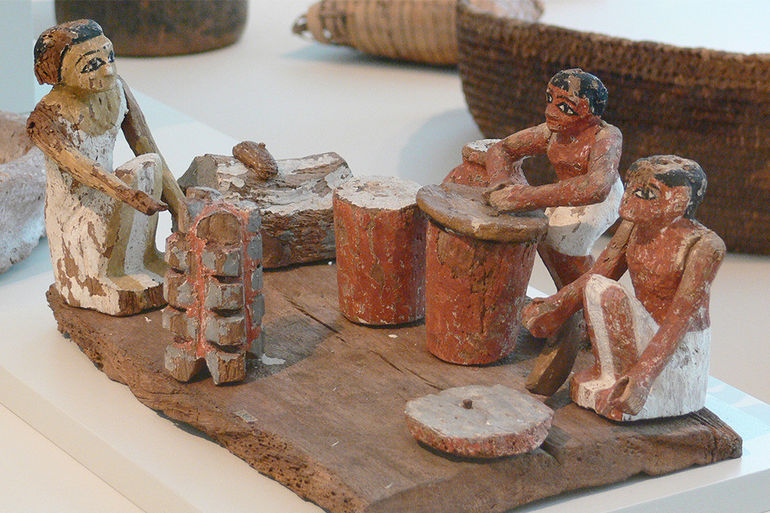Ancient Times
The first traces of beer date back to 4500 BC in Mesopotamia. At the time, beer was brewed using barley or spelt bread. Traces of the history of beer have also been found among the Celts in Northern Europe. According to some historians, the origins of beer go as far back as 7000 BC.
The most common ancient brewing technique was that of beer breads, which were found later on in Egypt. These malted barley or spelt breads were crumbled in a tank filled with sweetened water. The crumbs would macerate and eventually ferment, transforming part of the sweetened water into alcohol. Then, the divine drink was filtered and poured into jugs.
 Wood model that represents the Greek cuisine, 2500 - 1800 av. J.C.
Wood model that represents the Greek cuisine, 2500 - 1800 av. J.C.
Despite the presence of vineyards in the delta and the eastern part of the Egypt of the Pharaohs, beer undoubtedly became the national drink of the Egyptians. So much so that many historians have hypothesized the export of Egyptian brewery techniques to Gaul. However, these historians were mistaken, for the Gauls had their own processes of making "cervoise" or "barley beer", to which there are abundant testimonies in the first century AD. In particular, the Celts appeared to have already discovered the very modern phase of "malting", that is to say the preparation of the cereal by controlled germination.
The Romans and Greeks would prefer wine to beer, in terms of (simpler) manufacture. Yet, the Romans would still contribute to the spread of beer by exporting barley to areas where it had been unknown. In addition, in the regions of western and northern Europe, where the vine could not grow because of the climate, the Romans allowed the making of beer. It is also claimed that in "De Bello Gallico" Julius Caesar describes the cereal-based drink, drunk in aurochs horns by the Welsh, who did not particularly enjoy wine, preferring beer.
The Gauls therefore adopted, under the impulse of the Romans in the 3rd century, the beer that was called cervoise because of the grass that was mixed with the brew of cereals. The word is said to derive from Ceresis Vitis (vines of Ceres), and thus to evoke the goddess of harvests and cereals: Ceres, who donated this drink to peoples who could not get grape vines to grow.
At the time, women were in charge of preparing the cervoise. Each family had its own beer, the recipes were countless.
The Gauls contributed to the brewery culture with the invention of large barrels for fermentation and maturation, and smaller barrels, or casks, for conservation and transport.
From the 8th to the 11th century, the Vikings also drank cervoise, like the Gauls. However, the use of hops would not become common until much later. They produced a cervoise flavoured with honey and/or herbs, known as "gruit". They crushed the cereal mixed with water in tree trunks.
The Vikings drank Cervoise to quench their thirst, as well as to enter into a trance with the gods on the eve of battle.
 horn to drink
horn to drink
Delivery by the Swiss post or Drive-In (Pick up orders directly at the shops in St-Légier or Aigle)


Secure online payment




We answer to all your questions by phone on 021 943 51 81 or by mail at info@amstein.ch concerning order, delivery or product problems.
For questions relating to the website (connection issues, bad display, ...), please write us at eshop@amstein.ch.










